The Wahoo KICKR ROLLR Isn’t Your Grandpa’s Set Of Rollers
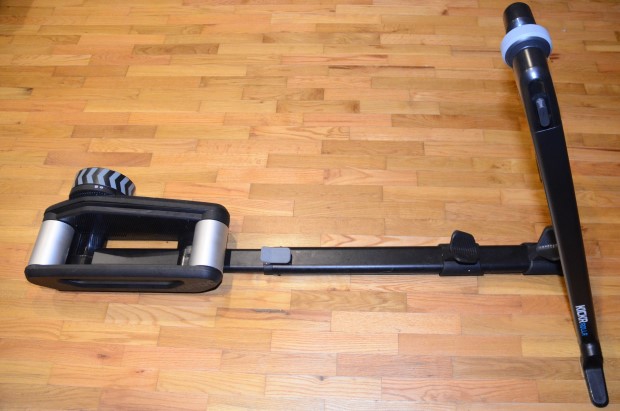
Despite what the name might suggest, the new Wahoo KICKR ROLLR isn’t a set of rollers, at least in the traditional sense. What it is, is a rear set of rollers linked to a front wheel tray and an armature to hold the wheel in that tray.
It isn’t much of a stretch to say that the design of this product owes a lot to previous products like the Feedback Sports (nee SportCrafters)
and Cateye trainers, which themselves were essentially a set of traditional rollers with the front wheel roller removed and replaced with a dummy axle.
This wasn’t exactly a new idea either, as Companies like Vetta had produced rear roller/front wheel stand trainers decades ago, and traditional rollers combined with a front wheel stand probably came into use right about the first time someone fell of their rollers. Wahoo has added some significant spice to this recipe, however.
First of all, the ROLLR is a smart trainer. Ish. The ROLLR doesn’t have any internal capacity to measure wattage, but it does contain an electronic resistance unit. This resistance level can be controlled by the Wahoo app, or by any of the typical virtual training programs/apps on the market like Zwift, Fulgaz or Wahoo’s own SYSTM. The ROLLR will output a speed metric to those programs/apps, and receive resistance control from them, so you can ride simulated terrain or erg workouts. Or, well… erg-ish. Remember, no power meter in the ROLLR.
Unless you already have a power meter on your bike. If you do, then the ROLLR instantly becomes a fully fledged smart trainer, as it is designed to link to your existing power meter and use that signal as the wattage output stream to feed whatever app/program you are using to drive the ROLLR. This happens pretty darn seamlessly, and in fact I didn’t even realize it was happening when I first used the ROLLR. When I review a product like this, I like to try and set it up without reading any of the literature that comes with it first, just to see how intuitive everything is, and what potential pitfalls might be out there for the folks who never read manuals. Based on my experience in customer service, there are a lot of them.
In this case I was not only able to get up and running without referring to the manual, I was able to connect the power meters of two different bikes to the ROLLR in order to feed it power data without knowing it was necessary to do so, or that I *had* done so. That’s pretty darn seamless, and a pretty big check in the win column.
You do need to have a power meter that is Bluetooth or ANT compatible to make this work. As that is essentially all of them these days, it’s pretty safe to say that if you’ve got a power meter, you’ll be able to drive power to the ROLLR.
As easy as I found it to drive the ROLLR with my power meter, that paled in comparison to how easy it is to put a bike on the unit, and to switch between bikes. The resistance unit isn’t attached to the bike, it’s just a set of rollers that the rear wheel, well, rolls on, and the front wheel just sits in this tray…
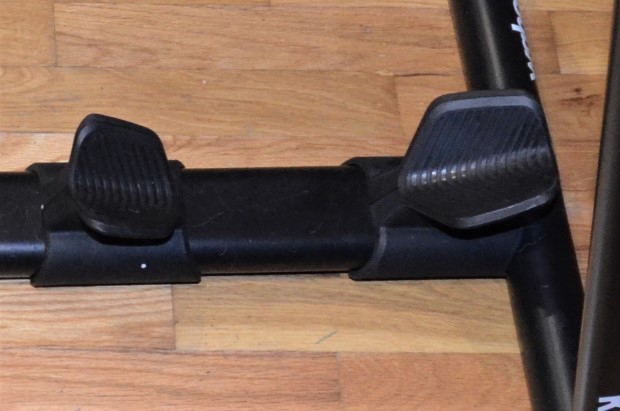
…and is held in place by two jaws, that you adjust by turning the grey rubber-ish wheel above them.
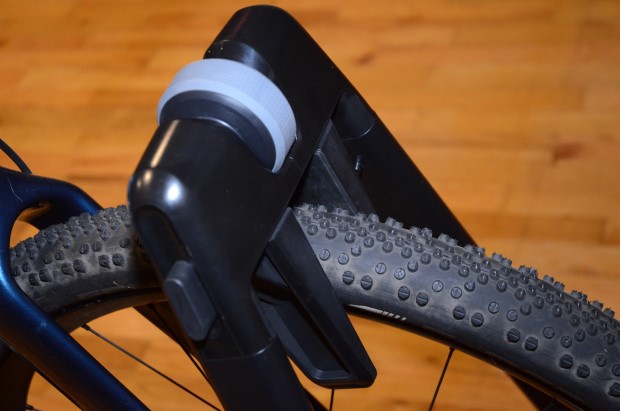
It isn’t even necessary to adjust the height of the front wheel to level the bike (assuming you have the same diameter wheels/tires on the front and the rear). This makes taking a bike on and off the trainer incredibly quick and easy, easier than any other trainer I have used, literally one operation removed from the “put the bike on and ride” simplicity of rollers, while still completely removing the rather steep learning curve of those devices…
Once your bike is on the ROLLR and linked up to your power meter and whatever program you’re using to drive it, you find that it basically does all the things one expects of a current generation indoor smart trainer. Kind of.
The combination of nothing holding your rear wheel in place on the rollers but your bodyweight, and the way that the front wheel connects to the trainer means that your bike can – and will – move around underneath you quite a bit on the ROLLR. The first bike I tried had a very lightweight set of race wheels on it, and the amount of front wheel movement when I rode hard out of the saddle was, frankly, disconcerting at first. Hi-torque/low cadence and out of the saddle, the front of the bike felt downright rubbery compared to the trainer setups I have become used to, as it moved well over a centimeter side to side. Meanwhile, the rear of the bike behaved – surprise! – like it was on rollers, with the lateral motion one would expect.
Once I got used to this movement – and the subconscious voice screaming “you’re going to fall over sideways!” quieted down – I found that the degree of bike movement allowed by the ROLLR made for a really great ride experience, especially over longer duration rides. Rocker platforms and articulated front wheel stands have become the object of fascination for a fairly large and devoted segment of the indoor riding population, and the ROLLR absolutely deserves consideration by those who are sold on the benefits of these products.
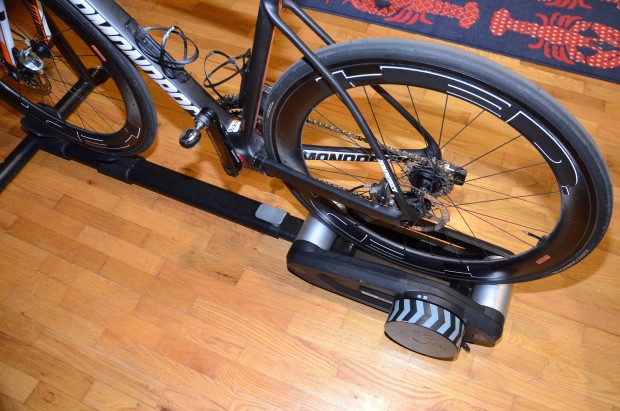
When I rode identical Fulgaz courses of up to about three hours on both the ROLLR and a more traditional trainer setup, I definitely experienced less “felt” fatigue after the session on the ROLLR. Riding the full Kona Fulgaz course on both setups, I was too wasted to feel much difference between them immediately post-ride, but the days following each ride, all my recovery metrics were ever so slightly better post-ROLLR.
The comparison setup I used for these rides was an Ipad connected via Bluetooth to either the ROLLR or a Wahoo Kickr with a Kickr CLIMB in place of the front wheel, all driven mostly by the Fulgaz app, with occasional detours into Wattopia on Zwift.
One of the things I appreciate most about Fulgaz is that it allows you to tackle simulated versions of some of the classic steep road climbs of European grand tour racing, with extended pitches well into the double digits, both up and down. Sharp, steep climbing that will find most riders wanting to get out of the saddle, and of a length that most other virtual riding environments don’t provide. If you want to test how an electronic trainer will respond on a 45 minute long simulated climb, Fulgaz is hard to beat.
In this environment, the differences between the ROLLR and the KICKR really stood out. In some ways the ROLLR is much more like riding out in the real world – all that lateral movement! – but in others, the Kickr/CLIMB combo is. Perhaps unsurprisingly, having the front end of the bike move up and down courtesy of the CLIMB makes descending and climbing feel much more realistic, but in addition – and especially on descents – the way that the KICKR simulates system inertia also feels much more in line with riding in real life. Steep sections that would have me completely spun out well in excess of 120 RPM on the KICKR/CLIMB were quite comfortable to pedal through on the ROLLR.
Turn those steep pitches around, though, and that’s where things really got interesting. The ROLLR, being neither fish nor fowl, does not fix the rear wheel in place like a traditional trainer, and it doesn’t float the front wheel on top of a third roller, like a traditional set of rollers. The front wheel is fixed in place (at least vertically) and the rear wheel floats. The result of this is that the axle of the front wheel becomes a hinge upon which the rest of the bike rotates, even if ever so slightly. Moving up and out of the saddle when using the ROLLR would noticeably decrease tire contact, to the point that resistance became lower, and the efforts became easier.

It’s not that the tire was slipping – it wasn’t – it’s that by shifting my weight bias forward, I decreased the weight on the rear tire, which resulted in a decrease in rolling resistance with a concomitant decrease in the wattage necessary to turn the rollers at a given speed for a given resistance. This effect was pronounced enough that while maintaining a constant speed and cadence, I could watch the wattage number drop on my power meter as I slowly moved out of the saddle and forward, and go back up again as I returned to the seated position. On a simulated 15% climb doing 300 watts in the saddle, I could maintain the same virtual speed with roughly 20 watts less output out of the saddle.
Needless to say, this is a pretty significant amount. Significant enough that I’m left wondering what the ramifications might be for the use of this device in certain virtual bike racing environments. If you happen to have been following the latest Zwift weight doping news this effect might sound a little bit familiar. It seems like this just might be a wee bit of an analog cheat code for a digital game.
While we’re talking about the analog world, and size and weight… the ROLLR is a sizeable piece of gear. It weighs 50 pounds, and while the front/stand section can detach and telescopes for adjustment and storage, it’s still going to take up a fair bit of real estate in your training cave or living room.
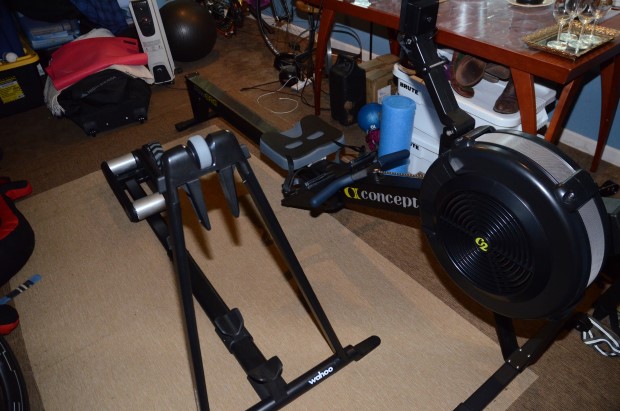
The roller section of the ROLLR will accommodate just about any tire, and the clamp on the front stand fits a tire up to about a 55 section. That should allow for just about any gravel bike…
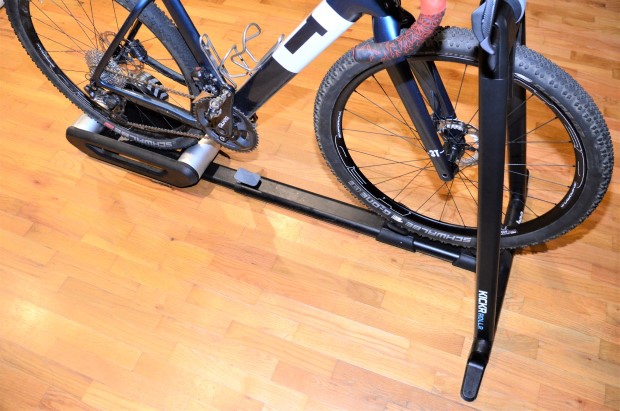
…but falls a fair bit short of what most folks are running on mountain bikes these days. This is a bit unfortunate, especially considering who I think should be pretty excited about this product. Namely, bike fitters.
The ROLLR is a bike fit cheat code, too. It literally takes seconds to put a bike on the unit, and it is completely format agnostic in terms of wheel/axle type. It just doesn’t matter at all whether you are running thru-axles, quick releases, or bolt-on track wheels. Things might get a wee bit noisy with knobby tires, but they will work fine. 700c Wheel? Fine. So is a 650. B or C. Doesn’t matter. It would probably take a little bit of finagling, but I’m pretty sure I could make the darn thing mate with a hand cycle. As it sits, you aren’t going to get a tandem on the ROLLR, but all it would take to do so is a single extension piece for the rail that connects the rear roller to the front clamp.
The ROLLR isn’t going to replace an adjustable fit bike for FIST style fits, but if you’re a fitter looking for a trainer to fine tune or adjust positions on existing bikes, this is the one you’ve been looking for. If you’re not a fitter, and you’re looking for something that is incredibly easy to use, will fit *most* of the bikes you might have in your stable without mucking about, and has a really enjoyable ride quality… game on.


Start the discussion at slowtwitch.northend.network